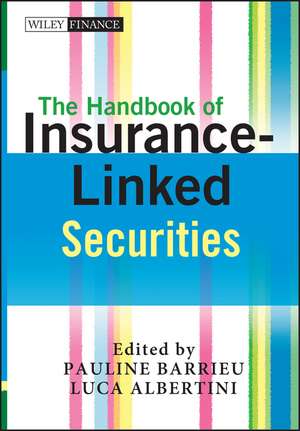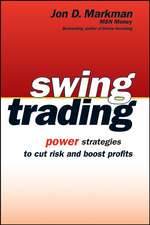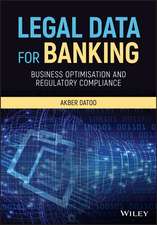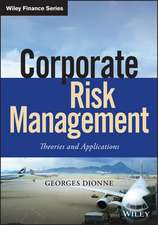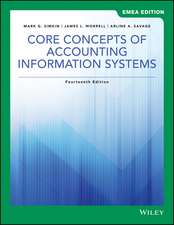The Handbook of Insurance–Linked Securities: The Wiley Finance Series
Editat de Pauline Barrieu, Luca Albertinien Limba Engleză Hardback – 9 iul 2009
--Paul Embrechts, Professor of Mathematics and Director of RiskLab, ETH Zurich The convergence of insurance with the capital markets has opened up an alternative channel for insurers to transfer risk, raise capital and optimize their regulatory reserves as well as offering institutions a source of relatively liquid investment with limited correlation with other exposures. One of the financial instruments allowing for the cession of insurance-related risks to the capital markets is Insurance-Linked Securities (ILS).
This book provides hands-on information essential for market participants, drawing on the insights and expertise of an impressive team of international market players, representing the various aspects and perspectives of this growing sector.
The book presents the state of the art in Insurance-Linked Securitization, by exploring the various roles for the different parties involved in the transactions, the motivation for the transaction sponsors, the potential inherent pitfalls, the latest developments and transaction structures and the key challenges faced by the market.
The book is organized into parts, each covering a specific topic or sector of the market. After a general overview of the ILS market, the Insurance-Linked Securitization process is studied in detail. A distinction is made between non-life and life securitization, due to the specificities of each sector. The process and all the actors involved are identified and considered in a comprehensive and systematic way. The concepts are first looked at in a general way, before the analysis of relevant case studies where the ILS technology is applied.
Particular focus is given to:
- the key stages in both non-life and life securitizations, including the general features of the transactions, the cedant's perspectives, the legal issues, the rating methodologies, the choice of an appropriate trigger and the risk modeling,
- the particular challenges related to longevity securitization,
- the investor's perspective and the question of the management of a portfolio of ILS, the general issues related to insurance-linked securitization, such as accounting and tax issues, regulatory issues and solvency capital requirements.
Din seria The Wiley Finance Series
- 20%
 Preț: 444.03 lei
Preț: 444.03 lei - 20%
 Preț: 432.78 lei
Preț: 432.78 lei - 20%
 Preț: 466.33 lei
Preț: 466.33 lei - 20%
 Preț: 508.39 lei
Preț: 508.39 lei - 20%
 Preț: 474.96 lei
Preț: 474.96 lei -
 Preț: 340.84 lei
Preț: 340.84 lei - 20%
 Preț: 384.23 lei
Preț: 384.23 lei -
 Preț: 344.22 lei
Preț: 344.22 lei - 8%
 Preț: 489.15 lei
Preț: 489.15 lei -
 Preț: 427.40 lei
Preț: 427.40 lei - 24%
 Preț: 573.28 lei
Preț: 573.28 lei - 20%
 Preț: 515.24 lei
Preț: 515.24 lei - 20%
 Preț: 507.63 lei
Preț: 507.63 lei - 20%
 Preț: 443.16 lei
Preț: 443.16 lei -
 Preț: 220.24 lei
Preț: 220.24 lei - 8%
 Preț: 340.90 lei
Preț: 340.90 lei -
 Preț: 432.06 lei
Preț: 432.06 lei -
 Preț: 274.91 lei
Preț: 274.91 lei - 20%
 Preț: 440.32 lei
Preț: 440.32 lei - 8%
 Preț: 532.04 lei
Preț: 532.04 lei - 8%
 Preț: 381.87 lei
Preț: 381.87 lei -
 Preț: 441.71 lei
Preț: 441.71 lei - 20%
 Preț: 429.01 lei
Preț: 429.01 lei -
 Preț: 444.59 lei
Preț: 444.59 lei -
 Preț: 195.81 lei
Preț: 195.81 lei -
 Preț: 363.83 lei
Preț: 363.83 lei - 20%
 Preț: 476.31 lei
Preț: 476.31 lei - 20%
 Preț: 429.68 lei
Preț: 429.68 lei - 24%
 Preț: 682.97 lei
Preț: 682.97 lei - 20%
 Preț: 482.01 lei
Preț: 482.01 lei - 20%
 Preț: 488.32 lei
Preț: 488.32 lei - 9%
 Preț: 1075.80 lei
Preț: 1075.80 lei - 9%
 Preț: 969.57 lei
Preț: 969.57 lei - 9%
 Preț: 745.28 lei
Preț: 745.28 lei - 8%
 Preț: 555.63 lei
Preț: 555.63 lei - 9%
 Preț: 767.24 lei
Preț: 767.24 lei - 8%
 Preț: 632.63 lei
Preț: 632.63 lei - 9%
 Preț: 789.52 lei
Preț: 789.52 lei - 9%
 Preț: 807.09 lei
Preț: 807.09 lei - 9%
 Preț: 706.01 lei
Preț: 706.01 lei - 8%
 Preț: 553.17 lei
Preț: 553.17 lei - 8%
 Preț: 615.85 lei
Preț: 615.85 lei - 9%
 Preț: 719.75 lei
Preț: 719.75 lei - 9%
 Preț: 888.44 lei
Preț: 888.44 lei - 9%
 Preț: 755.88 lei
Preț: 755.88 lei - 8%
 Preț: 708.98 lei
Preț: 708.98 lei - 9%
 Preț: 835.76 lei
Preț: 835.76 lei - 9%
 Preț: 961.77 lei
Preț: 961.77 lei - 9%
 Preț: 778.17 lei
Preț: 778.17 lei - 9%
 Preț: 954.94 lei
Preț: 954.94 lei
Preț: 954.85 lei
Preț vechi: 1049.29 lei
-9% Nou
Puncte Express: 1432
Preț estimativ în valută:
182.74€ • 190.07$ • 150.86£
182.74€ • 190.07$ • 150.86£
Carte tipărită la comandă
Livrare economică 14-28 aprilie
Preluare comenzi: 021 569.72.76
Specificații
ISBN-13: 9780470743836
ISBN-10: 0470743832
Pagini: 398
Dimensiuni: 170 x 244 x 21 mm
Greutate: 0.82 kg
Editura: Wiley
Seria The Wiley Finance Series
Locul publicării:Chichester, United Kingdom
ISBN-10: 0470743832
Pagini: 398
Dimensiuni: 170 x 244 x 21 mm
Greutate: 0.82 kg
Editura: Wiley
Seria The Wiley Finance Series
Locul publicării:Chichester, United Kingdom
Public țintă
Fund Managers, Risk managers, QuantsNotă biografică
Dr PAULINE BARRIEU is a Reader (associate professor) at the London School of Economics. She has two PhDs in Mathematics and in Finance. Her research interests are mainly on the study of problems at the interface between finance and insurance, in particular ILS. She also works on quantitative methods for risk measurement and robust decision taking, with applications in finance and environmental economics. LUCA ALBERTINI is Chief Executive Officer of Leadenhall Capital Partners, an asset management company dedicated to insurance linked investments strategies. Luca has over 16 year's securitisation experience, having worked at Citibank, GE Capital, Credit Suisse First Boston and at Swiss Re, where he became responsible for the European Insurance Linked Securities team.
Cuprins
Contents About the Contributors Acknowledgements 1 Introduction Pauline Barrieu and Luca Albertini PART I NON-LIFE SECURITISATION 2 Non-life Insurance Securitisation: Market Overview, Background and Evolution Jonathan Spry 3 Cedants' Perspectives on Non-life Securitization 3A Insurance-linked securities as part of advanced risk intermediation Insa Adena, Katharina Hartwig and Georg Rindermann 3B Reinsurance vs Securitisation Guillaume Gorge 3C Securitisation as a diversification from traditional retrocession Jean-Luc Besson 4 Choice of Triggers Dominik Hagedorn, Christian Heigl, Andreas Müller and Gerold Seidler 4.1 General aspects 4.2 Indemnity triggers 4.3 Non-indemnity triggers 4.4 Choosing the optimal trigger 5 Basis Risk from the Cedant's Perspective David Ross and Jillian Williams 5.1 Introduction 5.2 Investor vs sponsor risk 5.3 Trigger types 5.4 Catastrophe models 5.5 Sources of basis risk 5.6 Defining basis risk 5.7 Quantifying basis risk 5.8 Minimising basis risk 5.9 Conclusion Acknowledgements References 6 Rating Methodology Cameron Heath 6.1 Standard & Poor's ratings services' rating process 6.2 Risk analysis 6.3 Legal and swap documentation review process 6.4 Impact on sponsor References 7 Risk Modelling and the Role and Benefits of Cat Indices Ben Brookes 7.1 Components of a cat model 7.2 Insurance-linked securities 7.3 Cat indices 7.4 Summary 8 Legal Issues Malcolm Wattman, Matthew Feig, James Langston, and James Frazier 8.1 The note offering - federal securities law implications 8.2 The note offering - the offering circular 8.3 Types of transactions 8.4 Conclusion 9 The Investor Perspective (Non-Life) Luca Albertini 9.1 The creation of a sustainable and liquid market 9.2 Key transaction features from the investor perspective 9.3 Market evolution: the investor perspective 10 ILS Portfolio Monitoring Systems Tibor Winkler and John Stroughair 10.1 Introduction 10.2 Miu - An ILS platform in a convergent space 10.3 RMS library of cat bond characterisations 10.4 Conclusion 11 The Evolution and Future of Reinsurance Sidecars Douglas J. Lambert and Kenneth R. Pierce 11.1 A brief history of the brief history of sidecars 11.2 Sidecar structures 11.3 The appeal of sidecars 11.4 Structuring considerations 11.5 The outlook for sidecars 11.6 Conclusion 12 Case Study: A Cat Bond Transaction by SCOR (Atlas) Emmanuel Durousseau 12.1 Introduction: SCOR's recent history 12.2 Atlas III and IV: Background 12.3 Atlas: Main characteristics 12.4 Basis Risk 12.5 Total Return Swap 12.6 Conclusion Appendix A A.1 Definition of events A.2 Extension events 13 Case Study: Swiss Re's New Natural Catastrophe Protection Program (Vega) Jay Green and Jean-Louis Monnier 13.1 A positive evolution of Swiss Re's ILS strategy 13.2 Swiss Re accesses multi-event natural catastrophe coverage 13.3 The first ILS to use a cash reserve account as credit enhancement 13.4 Innovation leads to more efficient protection PART II LIFE SECURITISATION 14 General Features of Life Insurance-Linked Securitisation Norman Peard 14.1 Life insurer corporate and business structures, risks and products 14.2 Actors and their roles 14.3 Process 15 Cedants' Perspectives on Life Securitisation 15A A cedant's perspective on life securitisation Alison McKie 15A.1 Why securitise? 15A.2 Life ILS can be complex 15A.3 Outlook for life ILS 15B A cedant's perspective on life securitisation Chris Madsen 15B.1 Key considerations 15B.2 Examples of securitisation opportunities 15B.3 Differences between securitisation and reinsurance 16 Rating Methodology Harish Gohil 16.1 Fitch's approach to the rating process 16.2 Insurance risk analysis 16.3 Zest: a VIF case study References 17 Life Securitisation: Risk Modelling Steven Schreiber 17.1 Modelling of a catastrophic mortality transaction 17.2 Modelling of a VIF transaction 18 Life Insurance Securitisation: Legal Issues Jennifer Donohue 18.1 Monetisation of future cash flows 18.2 Legal aspects of life insurance securitisation - some key features 18.3 Some examples of value-in-force securitisation/monetisation 18.4 Outlook 19 The Investor Perspective (Life) Luca Albertini 19.1 Life insurance-linked risks and investor appetite 19.2 Key transaction features from the investor perspective 19.3 Market evolution: the investor perspective 20 Longevity Securitisation: Specific Challenges and Transactions Jennifer Donohue, Kirsty Maclean and Norman Peard 20.1 Mortality and longevity risk 20.2 A market for longevity risk 20.3 Key structural aspects of longevity risk securitisation 20.4 Some features of longevity risk 21 Longevity Risk Transfer: Indices and Capital Market Solutions Guy Coughlan 21.1 The nature of longevity risk 21.2 The market for longevity risk transfer 21.3 Importance of indices, tools and standards 21.4 Capital market instruments for longevity risk transfer 21.5 Customised vs standardised longevity hedges 21.6 Case study: customised longevity hedge 21.7 Implementing a standardised index-based longevity hedge 21.8 Conclusions References 22 Case Study: A Cat Mortality Bond by AXA (OSIRIS) Sylvain Coriat 22.1 Catastrophic pandemic risk 22.2 Considered risk transfer tools 22.3 Detailed structure 22.4 Risk analysis 22.5 Investors' reaction 22.6 Spread behaviour 22.7 Next steps Reference 23 Case Study: Some Embedded Value and XXX Securitisations Michael Eakins and Nicola Dondi 23.1 Embedded value securitisation - Avondale S.A. 23.2 XXX securitisation PART III TAX AND REGULATORY CONSIDERATIONS 24 The UK Taxation Treatment of Insurance-Linked Securities Adam Blakemore and Oliver Iliffe 24.1 The Directive and the taxation of UK ISPVs 24.2 Non-UK insurance special purpose vehicles 24.3 Indirect taxes and withholding of income tax Further reading 25 The US Federal Income Taxation Treatment of Insurance-Linked Securities David S. Miller and Shlomo Boehm 25.1 Avoiding US corporate income tax for the issuer 25.2 Withholding tax and excise tax 25.3 US federal income tax treatment of an investor in a catastrophe bond issuer: overview Reference 26 Regulatory Issues and Solvency Capital Requirements Mark Nicolaides, Simeon Rudin, Rick Watson and Katharina Hartwig 26.1 Regulatory issues relevant for ILS sponsors 26.2 Solvency I 26.3 Solvency II Appendix A: Standard formula, solvency capital requirement (SCR) Index
Descriere
This book provides a much needed reference for finance practitioners on the rapidly growing Insurance Linked Securities markets.
